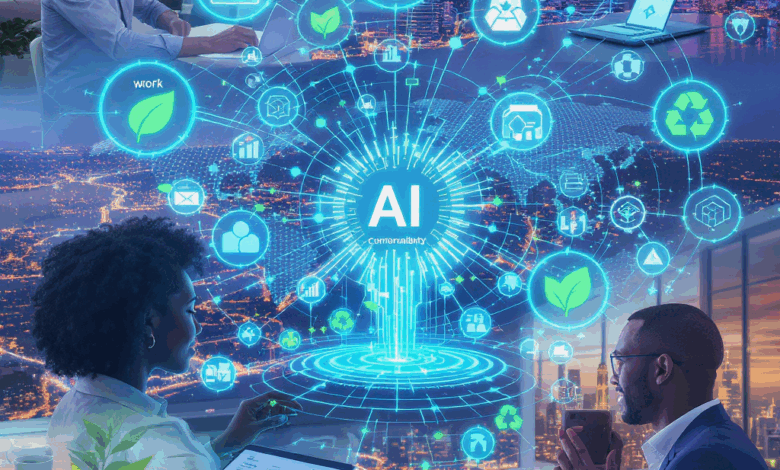Business Trends Unveiled – Key Insights and Practical Tips to Navigate Today’s Shifting Landscape

Business in Flux: Why You Can’t Afford to Miss What’s Next
The business world is no longer just about profits and products—it’s a dynamic arena where artificial intelligence, sustainability, and flexible work models are redefining success. Are you ready to understand the forces driving this change and what they mean for your business? This article reveals the crucial trends shaping industries today and offers practical advice to help you adapt and thrive amid uncertainty.
Artificial Intelligence From Experimentation to Enterprise Backbone
AI is no longer a futuristic concept; it’s now embedded deeply within top companies’ operations. Nearly half of Fortune 1000 firms have moved beyond pilots, scaling AI to automate complex tasks and improve decision-making. This rapid integration promises efficiency but demands careful, responsible adoption to avoid pitfalls.
Sustainability Moves to the Core of Business Strategy
Sustainability is more than a buzzword—it’s a competitive edge. Businesses are increasingly embracing circular economy principles, focusing on recycling and resource reuse to meet consumer expectations and regulatory demands. This shift not only protects the planet but also appeals to a growing base of eco-conscious customers.
The Remote Work Revolution Flexibility as the New Norm
Gone are the days when office presence defined productivity. Companies are now crafting hybrid and remote work policies that balance flexibility with performance. Investing in digital collaboration tools and nurturing a culture that supports work-life balance is essential for attracting and retaining talent.
Navigating Economic Uncertainty and Geopolitical Ripples
Economic sentiment among top U.S. CEOs has dipped to a five-year low, with many planning workforce reductions amid trade policy unpredictability. Meanwhile, cautious optimism in global markets follows diplomatic efforts delaying conflict escalation. Staying informed and agile is vital in this volatile environment.
Cybersecurity Guarding the Digital Frontier
As operations shift online, protecting sensitive data becomes paramount. Strengthening cybersecurity through regular updates, encryption, and employee education is no longer optional but a cornerstone of maintaining customer trust and business integrity.
Tip: Integrate AI thoughtfully, prioritize cybersecurity, embrace flexible work models, and embed sustainability into your core operations to stay competitive and resilient.
Engage with these insights to position your business at the forefront of change. The journey ahead is complex but navigable—are you ready to take the next step? Keep reading to unlock detailed strategies and real-world examples that will equip you for success.
Deep Dive into Agentic AI: Practical Implementation and Impact
Understanding Agentic AI in Business Contexts
Agentic AI refers to autonomous artificial intelligence systems capable of making decisions, performing complex tasks, and adapting without constant human oversight. Unlike traditional AI that assists with predefined tasks, agentic AI operates with a degree of independence, enabling businesses to automate workflows that involve dynamic problem-solving.
For instance, in supply chain management, agentic AI can independently reroute shipments based on real-time weather data and inventory levels, reducing delays without manual intervention. This capability is especially valuable for enterprises handling large-scale, multifaceted operations.
Step-by-Step Guide to Integrating Agentic AI
-
Assessment of Business Processes: Identify processes with repetitive decision-making or those requiring rapid responses to external changes.
-
Data Infrastructure Preparation: Ensure data quality and accessibility. Agentic AI thrives on diverse, real-time data inputs.
-
Pilot Deployment: Start with a contained scope, such as automating customer service responses or inventory management.
-
Performance Monitoring: Use key performance indicators (KPIs) like decision accuracy, response time, and customer satisfaction to evaluate effectiveness.
-
Scaling and Iteration: Gradually expand agentic AI applications, incorporating feedback and refining algorithms.
Cost Considerations and ROI
Initial investment in agentic AI can be significant, including software licensing, infrastructure upgrades, and staff training. Estimated costs for mid-sized companies range from $250,000 to $1 million annually depending on scope. However, operational savings, improved speed, and reduced errors can yield ROI within 18-24 months.
Challenges and Mitigation
-
Ethical and Compliance Risks: Autonomous decision-making can unintentionally perpetuate biases or violate regulations. Establish clear oversight frameworks.
-
Technical Complexity: Requires skilled personnel familiar with AI development and maintenance.
-
Change Management: Employees may resist automation; proactive communication is vital.
Expert Tip: Collaborate with AI vendors who offer customizable solutions and robust support to ensure smoother integration.
Practical Sustainability: Translating Circular Economy Principles into Action
Implementing Circular Practices Step by Step
Moving beyond theory, businesses need concrete methods to embed circular economy practices:
-
Material Audits: Conduct comprehensive reviews of all materials used across production and packaging to identify recyclable or reusable components.
-
Supplier Collaboration: Work with suppliers who provide sustainable inputs or take back used materials.
-
Product Design for Longevity: Design products that are modular, easy to repair, or upgrade rather than disposable.
-
Waste Stream Segregation: Invest in on-site sorting facilities to separate recyclable waste efficiently.
-
Consumer Engagement: Develop programs encouraging customers to return used products for recycling or refurbishment.
Comparative Analysis Linear vs Circular Models
| Aspect | Linear Model | Circular Model |
|---|---|---|
| Resource Utilization | Extract → Use → Dispose | Use → Recover → Reuse → Recycle |
| Cost Implications | Lower upfront, higher long-term | Higher initial investment, savings through reuse |
| Environmental Impact | High waste and emissions | Reduced waste and carbon footprint |
| Consumer Perception | Functional focus | Sustainability as value proposition |
Real-world Success Case Study
A mid-sized electronics manufacturer shifted to circular design by introducing modular smartphones. Customers could replace components instead of purchasing new devices. This change reduced electronic waste by 30% and increased customer loyalty, resulting in a 15% revenue uplift over two years.
Practical Barriers and Solutions
-
High Initial Costs: Offset through government grants or green financing.
-
Supply Chain Complexity: Use digital tracking (blockchain) to ensure traceability.
-
Consumer Behavior: Educate consumers on benefits and provide incentives for participation.
Practical Tip: Start small with pilot projects focusing on high-impact areas before company-wide implementation.
Mastering Remote Work: Building Effective Hybrid Work Cultures
Designing Flexible Work Policies
A successful hybrid policy balances employee autonomy with organizational goals. Consider these elements:
-
Core Hours: Establish overlapping hours for synchronous collaboration.
-
Remote Work Eligibility: Define roles suitable for remote work based on job functions and technology access.
-
Communication Protocols: Standardize tools and meeting etiquettes to avoid overload and miscommunication.
-
Performance Metrics: Shift focus from hours worked to outcomes achieved.
Digital Toolkits That Empower Teams
Equip employees with integrated platforms for communication, project management, and file sharing. Popular tools include Slack for messaging, Asana for task tracking, and Zoom for meetings. Ensure cybersecurity measures like VPNs and multi-factor authentication are in place.
Cultivating Company Culture Remotely
Maintaining culture requires intentional efforts:
-
Virtual Social Events: Casual meetups or themed online gatherings.
-
Recognition Programs: Highlight remote employees’ achievements publicly.
-
Feedback Loops: Regular surveys and town halls to capture employee sentiment.
Cost-Benefit Analysis of Hybrid Models
| Factor | Benefits | Challenges |
|---|---|---|
| Real Estate | Reduced office space costs | Need for flexible office setups |
| Talent Acquisition | Access to wider talent pool | Managing diverse time zones |
| Productivity | Improved work-life balance | Risk of isolation or burnout |
Expert Recommendations
- Train managers in remote leadership skills.
- Use data analytics to monitor collaboration patterns and intervene early if issues arise.
- Encourage regular check-ins without micromanagement.
Insight: Organizations that treat remote work as a strategic asset rather than a temporary fix outperform their peers in employee retention and innovation.
By delving into these advanced perspectives on agentic AI, sustainability implementation, and hybrid work culture, businesses can develop nuanced approaches that go beyond surface-level trends to create resilient, future-ready operations.

Synthesizing Key Insights for the Modern Business Landscape
Reflecting on the dynamic shifts detailed throughout this article, it’s clear that businesses today must embrace a multifaceted approach to remain relevant and competitive. The integration of agentic AI offers a pathway to automating complex decision-making processes, enhancing operational agility. At the same time, embedding sustainability into the core business strategy not only addresses environmental responsibilities but also aligns with evolving consumer values and regulatory frameworks. Meanwhile, cultivating effective hybrid work environments responds to the new expectations around flexibility and productivity.
These elements are not isolated trends; rather, they intertwine to create a resilient and forward-looking business model. Understanding this interconnectedness equips leaders and professionals to make informed choices that balance innovation, ethics, and human factors.
Practical Steps to Translate Insights into Action
Assess and Prioritize Initiatives
- Begin by evaluating which areas of your business stand to benefit most from autonomous AI applications, focusing on processes that involve rapid, data-driven decisions.
- Conduct material audits and collaborate with suppliers to identify opportunities for circular economy practices that reduce waste and enhance resource efficiency.
- Review your current work policies to determine how to best implement or refine hybrid models that support both employee well-being and business objectives.
Build Infrastructure and Capability
- Invest in robust data systems and cybersecurity measures to support AI deployment and protect digital assets.
- Offer training and clear communication to ease transitions and foster acceptance among employees adapting to new technologies and work modes.
- Leverage government incentives or green financing to mitigate initial costs associated with sustainability projects.
Monitor, Iterate, and Scale
- Establish clear KPIs such as operational efficiency, customer satisfaction, and environmental impact metrics to track progress.
- Pilot initiatives in controlled environments before broader implementation, allowing for adjustments based on real-world feedback.
- Encourage ongoing dialogue across teams to refine processes and sustain momentum.
Final Reflections Moving Forward with Confidence
Embracing change thoughtfully and intentionally is the cornerstone of enduring business success.
Navigating the complexities of today’s business environment requires more than reactive measures; it demands proactive leadership grounded in understanding and adaptability. By thoughtfully integrating agentic AI, committing to sustainability, and fostering flexible work cultures, businesses can unlock new opportunities and build trust with customers, employees, and stakeholders alike.
Remember, the goal is not to chase every trend but to align innovations with your unique business context and values. Start with manageable steps, stay informed, and cultivate a mindset open to learning and evolution.
For those eager to deepen their knowledge, exploring topics such as ethical AI governance, advanced circular economy frameworks, and remote leadership techniques can provide valuable next steps. Continuous learning will empower you to respond confidently to the shifting business landscape.
Your readiness to engage with these changes today lays the foundation for sustained growth and resilience tomorrow.

